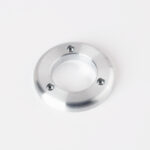FAQ
Does the LISST-OST come with internal logging and power?
Neither! The LISST-OST is designed for one purpose: Integration onto an Argo-type float for long-term (4-6 years) of unattended deployment in the deep sea. The LISST-OST requires -and only works with – external power and external logging.
The typical LISST-OST is integrated onto an Argo-type float and the float powers, controls, logs and transmits data from the LISST-OST together with data from all the other integrated sensors. The LISST-OST must be positioned on the float such that other components are not positioned directly above it. The LISST-OST will readily integrate onto a Second Star Robotics float and probably most floats from NKE (but do verify with them before purchase). If you have a float from another manufacturer, send the LISST-OST data sheet to them and ask them if their float can integrate the LISST-OST. Unfortunately, Sequoia cannot advise this, since it is completely dependent on the design of the float control circuitry and firmware.
It is crucial to understand that the LISST-OST relies on the float being able to log data from the LISST-OST continuously while drifting at parking depth for 5-10 days, i.e., BETWEEN the descent and ascent phases, see figure. Hundreds of measurements would have to be collected during the drift phase, typically at intervals determined by the desired time resolution of particle flux measurements. In the oligotrophic ocean intervals of 15 minutes to two hours and bursts of five to 20 seconds have worked well.
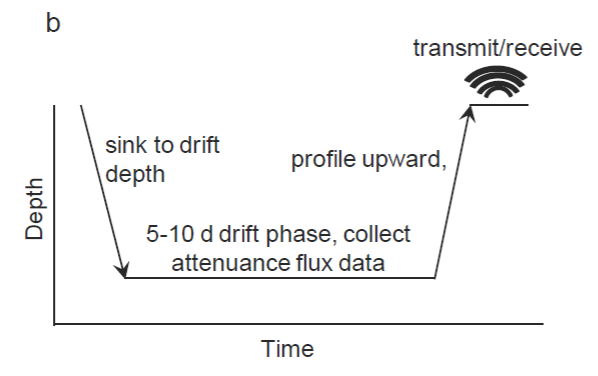
Not all floats can do this; only the float manufacturer can advise.
What if I don’t want to integrate it onto a float?
Then you must find a submersible datalogger and an external, submersible battery pack or other submersible power source. You also need to be able to wipe the collector window on a regular basis. For deployments in shallow water (< 60 m depth), Sequoia can supply a submersible datalogger / battery pack and a wiper. Contact us!
For deeper, non-float deployments, you must figure out your own datalogging, power source and wiper methodology.
How do I process the data from the LISST-OST in Lagrangian mode (deployed on a float)?
The LISST-OST is developed on NSF grant #2136735 awarded to Sequoia (Dr. Wayne Slade, Mr. Chuck Pottsmith) with University of Maine (Dr. Maragaret Estapa) as sub-contractor. The LISST-OST is based on the design recommendations in Estapa et al. (2024). She has also provided a set of MATLAB scripts for the global community to use; Estapa (2023). For data quality control, processing and analysis, you would typically use a version of the Estapa et al. (2024) method and the script in Estapa (2023), both adapted to your sampling needs and deployment specific considerations such as sampling period and profile cycle. For this reason, Sequoia does not provide any software for data QC, processing or analysis with the LISST-OST.
Estapa, M. L. et al. A new, global optical sediment trap calibration. Limnol. Oceanogr.: Methods 22, 77–92 (2024). DOI: https://doi.org/10.1002/lom3.10592 (paper is open access for everybody)
Estapa, M. Beam transmissometer optical sediment trap quality control software. (2023) doi:10.5281/zenodo.7595966 (open source).
How do I process the data from the LISST-OST in Eulerian mode?
That is a good question. Keep in mind that the LISST-OST was designed for one purpose: Integration onto an Argo-type float for long-term (4-6 years) unattended deployment in the deep sea while drifting at parking depth, typically somewhere between 1,000 m or 2,000 m depth. When deployed in Eulerian mode, the LISST-OST is stationary and water and particles flow past the instrument.
It is EXTREMELY important that you understand that the processing method described in Estapa et al. (2024) assumes that only particles accumulating on the window contribute to the increase in diffuse attenuation. Implicitly, it is assumed that there are no particles in the beam itself, and that the particles in the beam contribute negligibly to the diffuse attenuation compared to contribution from the particles on the window. This is a mostly valid assumption for an instrument in Lagrangian mode in the deep ocean: Here, there is no local particle production, there’s no resuspension, and there is no horizontal advection of particles. Particles can only arrive at the collector window by settling out from above, not from resuspension, local production or advection.
These assumptions do not hold at all for the LISST-OST when deployed in Eulerian mode. For example, a turbidity gradient advecting past the instrument, or a local resuspension event will add an unknown and time-varying contribution to the diffuse attenuation (from particles in the beam). This contribution must be subtracted from the total diffuse attenuation signal. It would look like this: Total Diffuse Attenuation = particles on the window + particles in the beam from advection + particles in the beam from resuspension.
You must find a method to estimate the contribution to the diffuse attenuation from the particles that are in the beam, then subtract that from each measurement of total diffuse attenuation to establish the diffuse attenuation from the particles on the window only. Once you have done that, you can use the approach in Estapa et al. (2024) to process the data. If such a method can generally be found is uncertain.
You should review the Estapa et al. (2024) paper and associated MATLAB script (Estapa, 2023) before you decide to use a LISST-OST in Eulerian mode.
Estapa, M. L. et al. A new, global optical sediment trap calibration. Limnol. Oceanogr.: Methods 22, 77–92 (2024). DOI: https://doi.org/10.1002/lom3.10592 (paper is open access for everybody).
Estapa, M. Beam transmissometer optical sediment trap quality control software. (2023) doi:10.5281/zenodo.7595966 (open source).
What sampling frequency should I use on a float?
It depends. If it is your own float, you can sample as fast as you like within your power budget. The LISST-OST draws 42 mA @ 12 V while measuring, which is 504 mW or 0.504 J/s. Sampling every 5-10 minutes will get you very high-resolution data, but data collected at lower frequencies, e.g. once an hour are likely to work well in the deep ocean.
If you are integrating onto a float within the BGC-Argo program, power consumption becomes an issue as 80% or more of the float power budget is reserved for the core BGC-Argo measurements. The TOTAL power budget for a BGC-Argo float is typically 4,500 kJ to 5,200 kJ, so this leaves 900 kJ to 1,040 kJ for the LISST-OST for the lifetime of the float.
The tables below shows (in green) the combination of burst sample time (in seconds) and sample intervals (per hour) that will allow for 250 cycles with cycle lengths of two, six and 10 days while using 20% or less of the power budget.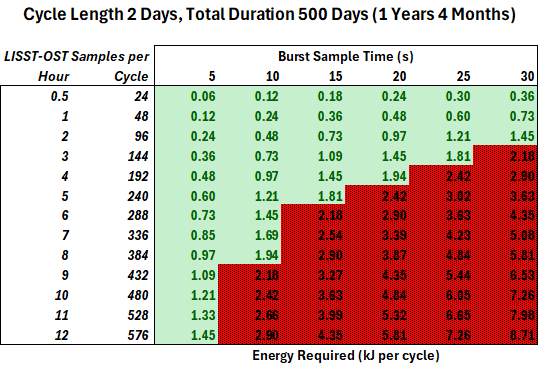
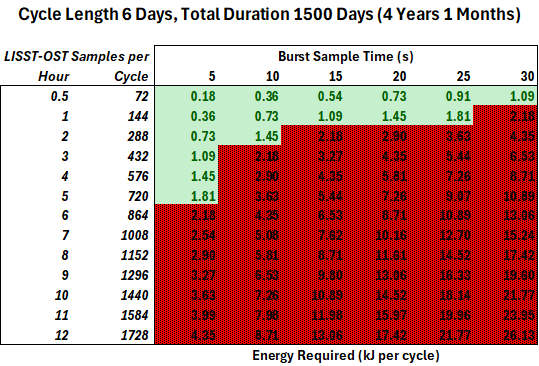
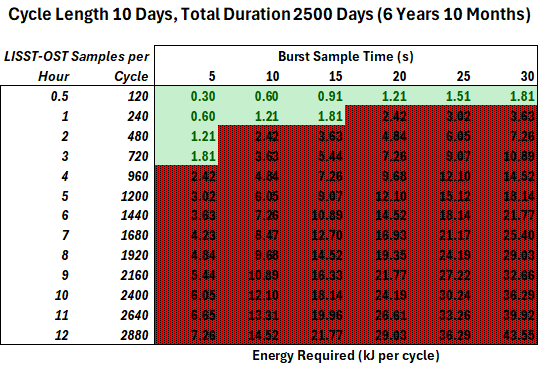
Why do you offer a wiper?
The wiper can be used when the LISST-OST is deployed in a Eulerian mode. E.g., on tripods, platforms or other stationary installations. For those applications, we cannot rely on accumulated sediment being wiped off the collector window as the LISST-OST ascends to the surface. The wiper is used to wipe the particles off the window at regular intervals and extend the deployment time.
Should I use the wiper if the LISST-OST is installed on a BGC-Argo float?
This is not at all recommended.
First, the wiper is rated to 100 m only.
Second, there is no need to wipe the window when the LISST-OST is integrated onto a float: Particles will be flushed off the window when the float ascends. Also, because the attenuance flux is a relative measurement (determined by change in the signal over time) it is calibration-independent as long as most of the material is removed periodically.
Third, the wiper is independently powered, and the wiper battery life is nowhere near long enough to last for a deployment lasting 4 to 5 years.
Is the wiper controlled by the LISST-OST?
No. The wiper is self-contained and cannot be controlled by the LISST-OST or any other external devices or instruments. The wipe interval must be manually set by the user before deployment and can only be changed by having physical access to the wiper.
What does the LISST-OST software do?
The software that comes with the LISST-OST is only for bench-top communication and functional checks of the instrument prior to deployment. The user must QC, process and analyse all data manually. Please read the two ‘How do I process the data…’ FAQs.
Can I rent the LISST-OST?
Can I buy cables for the LISST-OST?
Yes. But please note the following:
- If you are integrating the LISST-OST onto a float, the float manufacturer will almost certainly want to provide the cable between the LISST-OST and the float. Check with them first.
- If you need a cable to connect to the Nexsens datalogger for stationary deployments (i.e., in Eulerian mode), Sequoia can provide that. You need to specify the cable length when ordering.
- For other loggers and battery packs, for example the DH-4 from Sea-Bird (discontinued), Sequoia can also provide you with a cable. You must provide the detailed pin out and wiring diagram from your logger and battery pack and specify cable length. Note that it will almost certainly be cheaper and faster for you if you order the cable directly from a dedicated cable manufacturer such as SubConn or MacArtney.
What is included with the LISST-OST?
The LISST-OST comes with a ship case, Y-cable connecting the MCBH8M and MCBH3M connectors, 2 m communication cable connecting the Y-cable to a PC with USB, and a manual with software for functional checks only.
The LISST-OST does not come with any software for data QC, processing or analysis. You must QC, process and analyze the data manually following the Estapa et al. (2024) and Estapa (2023) procedures adapted to your local conditions:
Estapa, M. L. et al. A new, global optical sediment trap calibration. Limnol. Oceanogr.: Methods 22, 77–92 (2024). DOI: https://doi.org/10.1002/lom3.10592 (paper is open access for everybody).
Estapa, M. Beam transmissometer optical sediment trap quality control software. (2023) doi:10.5281/zenodo.7595966 (open source).
Does the LISST-OST work in rivers?
Sequoia cannot recommend the LISST-OST for use in rivers where there is a current. Keep in mind that ‘traditional’ suspended sediment traps from, e.g. McLane are not used in rivers because they don’t work well in these environments. For the same reasons, the LISST-OST will not work in rivers.






